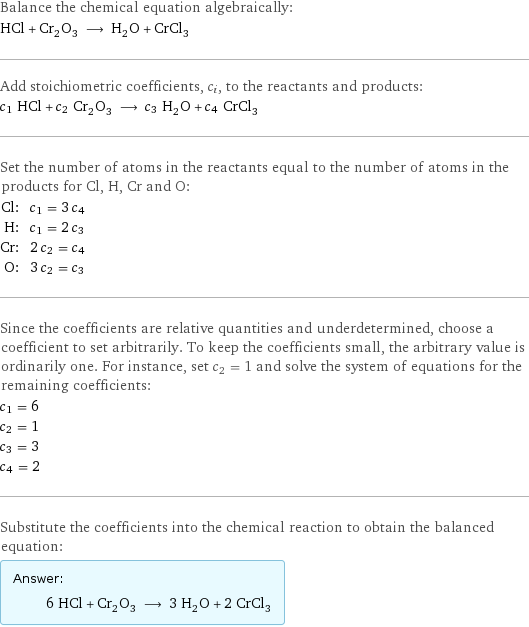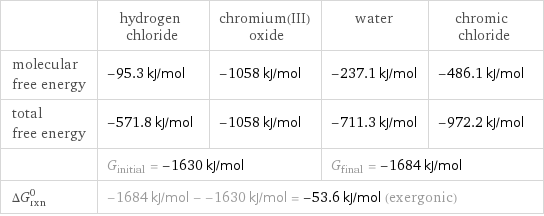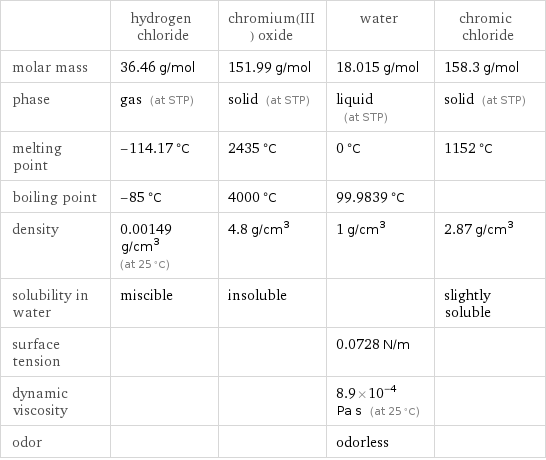Input interpretation

HCl hydrogen chloride + Cr_2O_3 chromium(III) oxide ⟶ H_2O water + CrCl_3 chromic chloride
Balanced equation

Balance the chemical equation algebraically: HCl + Cr_2O_3 ⟶ H_2O + CrCl_3 Add stoichiometric coefficients, c_i, to the reactants and products: c_1 HCl + c_2 Cr_2O_3 ⟶ c_3 H_2O + c_4 CrCl_3 Set the number of atoms in the reactants equal to the number of atoms in the products for Cl, H, Cr and O: Cl: | c_1 = 3 c_4 H: | c_1 = 2 c_3 Cr: | 2 c_2 = c_4 O: | 3 c_2 = c_3 Since the coefficients are relative quantities and underdetermined, choose a coefficient to set arbitrarily. To keep the coefficients small, the arbitrary value is ordinarily one. For instance, set c_2 = 1 and solve the system of equations for the remaining coefficients: c_1 = 6 c_2 = 1 c_3 = 3 c_4 = 2 Substitute the coefficients into the chemical reaction to obtain the balanced equation: Answer: | | 6 HCl + Cr_2O_3 ⟶ 3 H_2O + 2 CrCl_3
Structures

+ ⟶ +
Names

hydrogen chloride + chromium(III) oxide ⟶ water + chromic chloride
Reaction thermodynamics
Enthalpy

| hydrogen chloride | chromium(III) oxide | water | chromic chloride molecular enthalpy | -92.3 kJ/mol | -1140 kJ/mol | -285.8 kJ/mol | -556.5 kJ/mol total enthalpy | -553.8 kJ/mol | -1140 kJ/mol | -857.5 kJ/mol | -1113 kJ/mol | H_initial = -1694 kJ/mol | | H_final = -1970 kJ/mol | ΔH_rxn^0 | -1970 kJ/mol - -1694 kJ/mol = -277 kJ/mol (exothermic) | | |
Gibbs free energy

| hydrogen chloride | chromium(III) oxide | water | chromic chloride molecular free energy | -95.3 kJ/mol | -1058 kJ/mol | -237.1 kJ/mol | -486.1 kJ/mol total free energy | -571.8 kJ/mol | -1058 kJ/mol | -711.3 kJ/mol | -972.2 kJ/mol | G_initial = -1630 kJ/mol | | G_final = -1684 kJ/mol | ΔG_rxn^0 | -1684 kJ/mol - -1630 kJ/mol = -53.6 kJ/mol (exergonic) | | |
Equilibrium constant
![Construct the equilibrium constant, K, expression for: HCl + Cr_2O_3 ⟶ H_2O + CrCl_3 Plan: • Balance the chemical equation. • Determine the stoichiometric numbers. • Assemble the activity expression for each chemical species. • Use the activity expressions to build the equilibrium constant expression. Write the balanced chemical equation: 6 HCl + Cr_2O_3 ⟶ 3 H_2O + 2 CrCl_3 Assign stoichiometric numbers, ν_i, using the stoichiometric coefficients, c_i, from the balanced chemical equation in the following manner: ν_i = -c_i for reactants and ν_i = c_i for products: chemical species | c_i | ν_i HCl | 6 | -6 Cr_2O_3 | 1 | -1 H_2O | 3 | 3 CrCl_3 | 2 | 2 Assemble the activity expressions accounting for the state of matter and ν_i: chemical species | c_i | ν_i | activity expression HCl | 6 | -6 | ([HCl])^(-6) Cr_2O_3 | 1 | -1 | ([Cr2O3])^(-1) H_2O | 3 | 3 | ([H2O])^3 CrCl_3 | 2 | 2 | ([CrCl3])^2 The equilibrium constant symbol in the concentration basis is: K_c Mulitply the activity expressions to arrive at the K_c expression: Answer: | | K_c = ([HCl])^(-6) ([Cr2O3])^(-1) ([H2O])^3 ([CrCl3])^2 = (([H2O])^3 ([CrCl3])^2)/(([HCl])^6 [Cr2O3])](../image_source/8f381d75f48f5f3845e142067ef1c13b.png)
Construct the equilibrium constant, K, expression for: HCl + Cr_2O_3 ⟶ H_2O + CrCl_3 Plan: • Balance the chemical equation. • Determine the stoichiometric numbers. • Assemble the activity expression for each chemical species. • Use the activity expressions to build the equilibrium constant expression. Write the balanced chemical equation: 6 HCl + Cr_2O_3 ⟶ 3 H_2O + 2 CrCl_3 Assign stoichiometric numbers, ν_i, using the stoichiometric coefficients, c_i, from the balanced chemical equation in the following manner: ν_i = -c_i for reactants and ν_i = c_i for products: chemical species | c_i | ν_i HCl | 6 | -6 Cr_2O_3 | 1 | -1 H_2O | 3 | 3 CrCl_3 | 2 | 2 Assemble the activity expressions accounting for the state of matter and ν_i: chemical species | c_i | ν_i | activity expression HCl | 6 | -6 | ([HCl])^(-6) Cr_2O_3 | 1 | -1 | ([Cr2O3])^(-1) H_2O | 3 | 3 | ([H2O])^3 CrCl_3 | 2 | 2 | ([CrCl3])^2 The equilibrium constant symbol in the concentration basis is: K_c Mulitply the activity expressions to arrive at the K_c expression: Answer: | | K_c = ([HCl])^(-6) ([Cr2O3])^(-1) ([H2O])^3 ([CrCl3])^2 = (([H2O])^3 ([CrCl3])^2)/(([HCl])^6 [Cr2O3])
Rate of reaction
![Construct the rate of reaction expression for: HCl + Cr_2O_3 ⟶ H_2O + CrCl_3 Plan: • Balance the chemical equation. • Determine the stoichiometric numbers. • Assemble the rate term for each chemical species. • Write the rate of reaction expression. Write the balanced chemical equation: 6 HCl + Cr_2O_3 ⟶ 3 H_2O + 2 CrCl_3 Assign stoichiometric numbers, ν_i, using the stoichiometric coefficients, c_i, from the balanced chemical equation in the following manner: ν_i = -c_i for reactants and ν_i = c_i for products: chemical species | c_i | ν_i HCl | 6 | -6 Cr_2O_3 | 1 | -1 H_2O | 3 | 3 CrCl_3 | 2 | 2 The rate term for each chemical species, B_i, is 1/ν_i(Δ[B_i])/(Δt) where [B_i] is the amount concentration and t is time: chemical species | c_i | ν_i | rate term HCl | 6 | -6 | -1/6 (Δ[HCl])/(Δt) Cr_2O_3 | 1 | -1 | -(Δ[Cr2O3])/(Δt) H_2O | 3 | 3 | 1/3 (Δ[H2O])/(Δt) CrCl_3 | 2 | 2 | 1/2 (Δ[CrCl3])/(Δt) (for infinitesimal rate of change, replace Δ with d) Set the rate terms equal to each other to arrive at the rate expression: Answer: | | rate = -1/6 (Δ[HCl])/(Δt) = -(Δ[Cr2O3])/(Δt) = 1/3 (Δ[H2O])/(Δt) = 1/2 (Δ[CrCl3])/(Δt) (assuming constant volume and no accumulation of intermediates or side products)](../image_source/0a7f70ed9e9ece3146fc9e87d859d131.png)
Construct the rate of reaction expression for: HCl + Cr_2O_3 ⟶ H_2O + CrCl_3 Plan: • Balance the chemical equation. • Determine the stoichiometric numbers. • Assemble the rate term for each chemical species. • Write the rate of reaction expression. Write the balanced chemical equation: 6 HCl + Cr_2O_3 ⟶ 3 H_2O + 2 CrCl_3 Assign stoichiometric numbers, ν_i, using the stoichiometric coefficients, c_i, from the balanced chemical equation in the following manner: ν_i = -c_i for reactants and ν_i = c_i for products: chemical species | c_i | ν_i HCl | 6 | -6 Cr_2O_3 | 1 | -1 H_2O | 3 | 3 CrCl_3 | 2 | 2 The rate term for each chemical species, B_i, is 1/ν_i(Δ[B_i])/(Δt) where [B_i] is the amount concentration and t is time: chemical species | c_i | ν_i | rate term HCl | 6 | -6 | -1/6 (Δ[HCl])/(Δt) Cr_2O_3 | 1 | -1 | -(Δ[Cr2O3])/(Δt) H_2O | 3 | 3 | 1/3 (Δ[H2O])/(Δt) CrCl_3 | 2 | 2 | 1/2 (Δ[CrCl3])/(Δt) (for infinitesimal rate of change, replace Δ with d) Set the rate terms equal to each other to arrive at the rate expression: Answer: | | rate = -1/6 (Δ[HCl])/(Δt) = -(Δ[Cr2O3])/(Δt) = 1/3 (Δ[H2O])/(Δt) = 1/2 (Δ[CrCl3])/(Δt) (assuming constant volume and no accumulation of intermediates or side products)
Chemical names and formulas

| hydrogen chloride | chromium(III) oxide | water | chromic chloride formula | HCl | Cr_2O_3 | H_2O | CrCl_3 Hill formula | ClH | Cr_2O_3 | H_2O | Cl_3Cr name | hydrogen chloride | chromium(III) oxide | water | chromic chloride IUPAC name | hydrogen chloride | | water | trichlorochromium
Substance properties

| hydrogen chloride | chromium(III) oxide | water | chromic chloride molar mass | 36.46 g/mol | 151.99 g/mol | 18.015 g/mol | 158.3 g/mol phase | gas (at STP) | solid (at STP) | liquid (at STP) | solid (at STP) melting point | -114.17 °C | 2435 °C | 0 °C | 1152 °C boiling point | -85 °C | 4000 °C | 99.9839 °C | density | 0.00149 g/cm^3 (at 25 °C) | 4.8 g/cm^3 | 1 g/cm^3 | 2.87 g/cm^3 solubility in water | miscible | insoluble | | slightly soluble surface tension | | | 0.0728 N/m | dynamic viscosity | | | 8.9×10^-4 Pa s (at 25 °C) | odor | | | odorless |
Units
